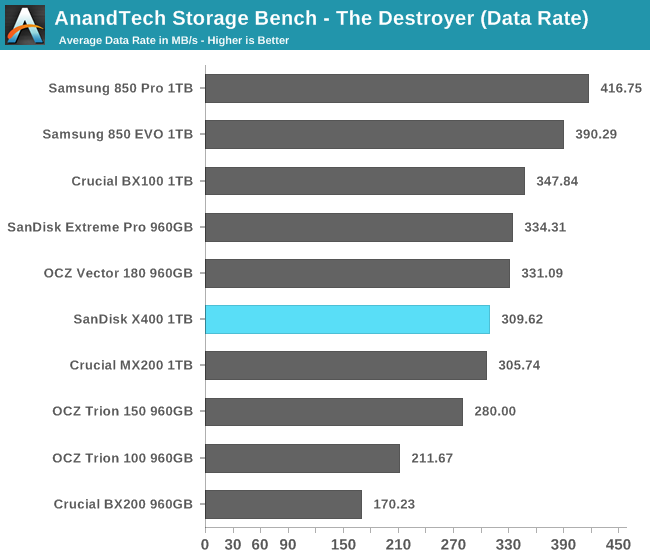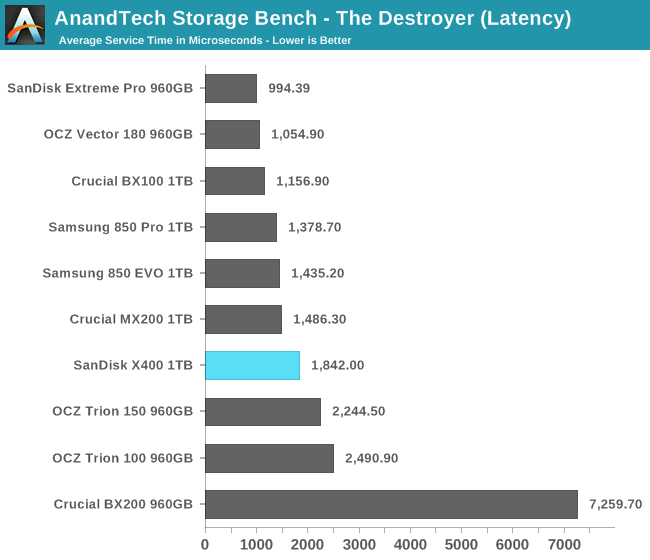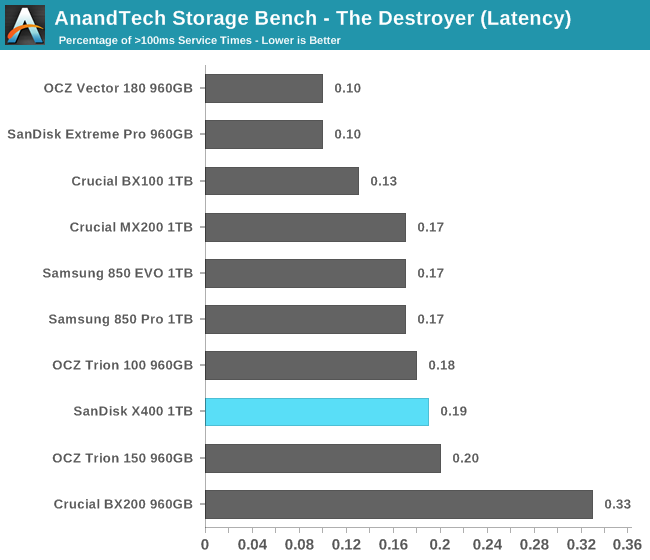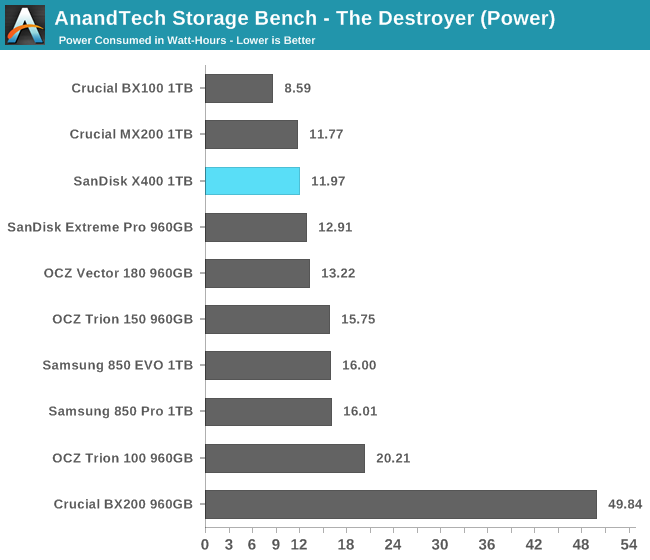The SanDisk X400 1TB SSD Review
by Billy Tallis on May 6, 2016 9:00 AM ESTAnandTech Storage Bench - The Destroyer
The Destroyer is an extremely long test replicating the access patterns of very IO-intensive desktop usage. A detailed breakdown can be found in this article. Like real-world usage and unlike our Iometer tests, the drives do get the occasional break that allows for some background garbage collection and flushing caches, but those idle times are limited to 25ms so that it doesn't take all week to run the test.
We quantify performance on this test by reporting the drive's average data throughput, a few data points about its latency, and the total energy used by the drive over the course of the test.

The X400's average data rate on The Destroyer places it clearly ahead of the other planar TLC drives and on par with the Crucial MX200.

The average service time for the X400 doesn't quite compete against the MLC drives, but it does put the X400 clearly ahead of the budget TLC drives.

The X400's latency outliers at the 10ms threshold again put it ahead of the budget drives but also clearly behind the MLC drives and the Samsung 850 EVO.

At the 100ms threshold for latency outliers most drives in this roundup score very close to each other, and the X400 is a little slower than average.

The X400's power usage over the course of The Destroyer is pretty good, especially for a TLC drive. Most of the faster drives sacrifice some efficiency.










41 Comments
View All Comments
Chaitanya - Friday, May 6, 2016 - link
1TB capacity in M.2 Form factor is tempting.nathanddrews - Friday, May 6, 2016 - link
I like the $/GB, but there aren't enough GBs.Namisecond - Sunday, May 8, 2016 - link
Maybe you need to stop treating SSDs as bulk storage?dsumanik - Sunday, May 8, 2016 - link
Maybe you should go back to floppies.It's 2016 and there is no reason for magnetic drives to be alive. Yes yes, I know about cost per gig and all the stats you feel like googling and quoting to me to prove how smart you are, but the real truth is this: it's way more profitable to sell us 50 year old technology cuz dums dums will keep on buying.
Bring on xpoint, it'll help push traditional flash down into the bargain bin... And for u sir, Ii will gladly mail you my original dos 6.22 install disks if you simply shut the f**k up.
santeana - Monday, May 9, 2016 - link
LMAO! I wish there was a like button!+1
blakeatwork - Monday, May 9, 2016 - link
It's a process of how quickly do you need to access certain types of data. OS, programs and games all benefit from being on an SSD (assuming supporting architecture does not have any obvious bottlenecks). I'm not sure browsing photos from a recent vacation really provides the necessary strain on your I/O that requires an SSD :DMagnetic drives will stick around for quite a while, especially for Home/SMB NAS devices where the amount of storage is greater then the perceived need for super fast access, which is throttled by GbE network (or WiFi) anyways
bug77 - Tuesday, May 10, 2016 - link
Modern operating system do lots of stuff in the background, an AV may scan your drives from time to time. This is stuff that kills IO on a HDD and that barely registers on a SSD. So there are reason for moving away from HDDs... But yes, the HDD will stick around for a while, simply because of pricing.jordanclock - Saturday, July 2, 2016 - link
Good thing we just dump all old technology as soon as we find a replacement!edward1987 - Thursday, September 22, 2016 - link
1TB is quite out of my pocket £218 (http://www.span.com/product/SanDisk-X400-SSD-SD8SN... but 512GB I would not mind. If you have Qnap tvs-1282 server or similar - they have m.2 for caching or tiered storage. I can use for it in there.HollyDOL - Friday, May 6, 2016 - link
There is a mismatch in Specification table:1TiB (1024GB) should be 1TB(1000GB)
According to specs at https://www.sandisk.com/content/dam/sandisk-main/e...
putting 10^3n and 2^10n prefixes together is just incorrect anyway without correct recalculation...